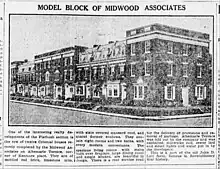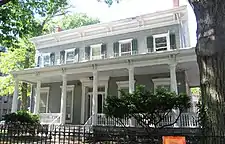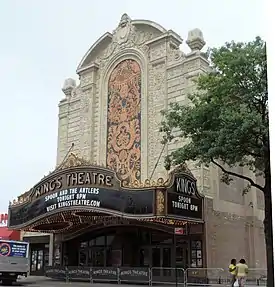Albemarle–Kenmore Terraces Historic District
The Albemarle–Kenmore Terraces Historic District is a small historic district located in the Flatbush neighborhood of Brooklyn, New York City. It consists of two short cul-de-sacs, Albemarle Terrace and Kenmore Terrace, off of East 21st Street, and the 32 houses on the two streets,[4] as well as a four-family apartment building at the end of Albemarle Terrace. The New York City Landmarks Preservation Commission, which designated the district as a landmark in 1978, noted that the "terraces are distinguished by the uniform use of materials, height and color producing a harmonious effect".[5]
Albemarle–Kenmore Terraces Historic District | |
 top: Albemarle Terrace, south side (September 2012) bottom: Kenmore Terrace, south side (August 2013) | |
   | |
| Location | Albemarle Terr. & Kenmore Terr. at E. 21st St. Brooklyn, New York City |
|---|---|
| Coordinates | 40°39′3″N 73°57′33″W |
| Area | 2 acres (0.81 ha) |
| Built | 1916-20 |
| Architect | Slee & Bryson |
| Architectural style | Albemarle: Colonial Revival[1] Kenmore: English Arts & Crafts[2] |
| NRHP reference No. | 83001685[3] |
| Significant dates | |
| Added to NRHP | June 30, 1983 |
| Designated NYCL | July 11, 1978 |
Architecture
The structures were designed by the local firm of Slee & Bryson, but differ in style between the two streets.
Albemarle Terrace
The houses on Albemarle Terrace, built between 1916 and 1917, are Colonial Revival[1] two and one-half- or three-story brick buildings located on courts and raised above street level behind terraces or front gardens.[6] Many of these gardens are shaded by a generous canopy of mature Pin Oak trees. The buildings on Albemarle Terrace have long been praised by architectural critics as "the most fully realized Neo-Federal houses in the city—especially the smaller, gabled houses with dormers—they represent perfect bookends of New York's row house building history stretching from 1783 to 1917".[7]

The southern row of Albemarle Terrace was constructed from 1916 to 1917 as the "model" homes and were generally alike in form and finish. The homes on the northern row were constructed between 1917 and 1918, and buyers were able to choose from an array of trim packages and finishes inside.
Both rows use the same material: red brick (with occasional burned singles) laid up in the Flemish bond pattern, limestone ornament, white-painted wood trim. Two general types of structure are used in both rows: "an 'A' type of three stories with flat roofs, and a 'B' type of two stories with a pitched attic story".[8] Each type has two subtypes, with variance in fenestration between the two. For the A-type, A1 features four symmetrical 6-over-6 double hung windows on the upper two floors, while the second story of A2 features a triple window, underneath an elliptical arch with a fluted sunburst design.[8] For the B-type, B1 features a triple-windowed bay at the first story, and a rectangular doorway consisting of a multi-light paneled door with a leaded glass transom, flanked by fluted pilasters, and topped with a limestone lintel carved with a paneled urn motif. B2 has an unbroken front facade, with a triple window instead of the bay, and an arched doorway with leaded glass fanlight flanked by Greek-revival style Doric colonettes.[8] Copper roofing adorns the enclosed stoops on the A-type houses, as well as the dormers and bay windows on the B-types, with the pitched attic stories finished with Vermont Green slate roofs.
Kenmore Terrace
On Kenmore Terrace, three of the houses are also in the Colonial Revival style, one of which was built in 1918 and other two in 1919–20,[5] but the remaining six on the south side of the street show the influence of the Garden city movement,[5] and were designed in the English Arts and Crafts style.[2] These Kenmore cottages were built in 1918–19,[5] and presage the automobile-based look of many suburbs built in the decades to come, as each house has a driveway leading to a private garage.[1]
Historic designation
The historic district was designated by the New York City Landmarks Preservation Commission in 1978,[1] and was listed on the National Register of Historic Places in 1983.[3]
 File:Albemarle-plaque.jpg
File:Albemarle-plaque.jpg File:Kenmore-plaque.jpg
File:Kenmore-plaque.jpg
Notable surroundings
Located on Kenmore Terrace, but not part of the historic district, is the landmarked parsonage of the Flatbush Reformed Dutch Church, a two and one-half-story wood-frame house designed in a vernacular style transitional between the Greek Revival and Italianate styles.[9] The parsonage was built in 1853 on the west side of Flatbush Avenue (near present-day 892 Flatbush Avenue), and moved to its present location in 1918.
The historic district is close to a number of other New York City landmarks, such as Erasmus Hall High School, Flatbush Town Hall, Kings Theater, and the now-razed Flatbush District No.1 School (landmarked in 2007,[10] but demolished in 2015[11]) which was built in 1890 atop the site of the Flatbush African Burial Ground. The United States Post Office - Flatbush Station stands across from the site of the former school, and is listed on the U.S. National Register of Historic Places.
Additionally, a handful of non-landmarked architecturally significant buildings stand nearby:
The former Keith-Albee Kenmore Theatre stands at 2101 Church Avenue. It originally opened in 1928 as a vaudeville house, and later became a single screen movie theater, split up into four screens in 1970.[12] The theater is now occupied by retail chain Target, among others. The building was designed by Eugene De Rosa,[12][13] with its southern elevation adorned with Colonial Revival architectural vernacular similar to the buildings on Albemarle Terrace, as well as the church house of the Flatbush Reformed Dutch Church opposite it. The building that once housed the office of Midwood Associates—the developer of the historic district—still stands at 2127 Church Avenue/882 Flatbush Avenue, with marquees bearing the branding "Midwood Associates Buildings" along the southern and eastern façades.
 Parsonage of the Flatbush Dutch Reformed Church at 2103 Kenmore Terrace
Parsonage of the Flatbush Dutch Reformed Church at 2103 Kenmore Terrace Flatbush Reformed Dutch Church at 890 Flatbush Avenue
Flatbush Reformed Dutch Church at 890 Flatbush Avenue Church house of the Flatbush Reformed Dutch Church
Church house of the Flatbush Reformed Dutch Church Keith-Albee Kenmore Theatre at 2101 Church Avenue
Keith-Albee Kenmore Theatre at 2101 Church Avenue Erasmus Hall High School at 911 Flatbush Avenue
Erasmus Hall High School at 911 Flatbush Avenue United States Post Office - Flatbush Station at 2273 Church Avenue
United States Post Office - Flatbush Station at 2273 Church Avenue.jpg.webp) Flatbush Town Hall at 35 Snyder Avenue
Flatbush Town Hall at 35 Snyder Avenue Kings Theatre at 1027 Flatbush Avenue
Kings Theatre at 1027 Flatbush Avenue
Transportation
The historic district is closest to the New York City Subway station at Church Avenue (B and Q trains) and is accessible via two MTA-operated local bus routes: the B35 on Church Avenue, and the B41 route on Flatbush Avenue.[14]
See also
References
Notes
- New York City Landmarks Preservation Commission; Dolkart, Andrew S.; Postal, Matthew A. (2009). Postal, Matthew A. (ed.). Guide to New York City Landmarks (4th ed.). New York: John Wiley & Sons. ISBN 978-0-470-28963-1. p.263
- White, Norval; Willensky, Elliot; Leadon, Fran (2010). AIA Guide to New York City (5th ed.). New York: Oxford University Press. ISBN 978-0-19538-386-7. p.713
- "National Register Information System". National Register of Historic Places. National Park Service. March 13, 2009.
- New York City Geographic Information System map
- New York City Landmarks Preservation Commission "Albemarle–Kenmore Terraces Historic District Designation Report" Archived March 1, 2017, at the Wayback Machine (July 11, 1978)
- Covell, Anne B. (n.d.). "National Register of Historic Places Registration:Albemarle–Kenmore Terraces Historic District". New York State Office of Parks, Recreation and Historic Preservation. Retrieved March 6, 2011. See also: "Accompanying six photos".
- Lockwood, Charles (2019). Bricks & brownstone : the New York row house. Patrick W. Ciccone, Jonathan D. Taylor, Fran Leadon, Dylan Chandler, New York Landmarks Conservancy. New York. p. 343. ISBN 978-0-8478-6589-5. OCLC 1121477777.
{{cite book}}: CS1 maint: location missing publisher (link) - New York (N.Y.). Landmarks Preservation Commission. (1974). Albermarle-Kenmore Terraces proposed historic district /. Columbia University Libraries. New York, N.Y. : The Commission.
- New York City Landmarks Preservation Commission; Dolkart, Andrew S.; Postal, Matthew A. (2009). Postal, Matthew A. (ed.). Guide to New York City Landmarks (4th ed.). New York: John Wiley & Sons. ISBN 978-0-470-28963-1. p.285
- "Flatbush District No. 1 School | HDC". hdc.org. July 31, 2018. Retrieved August 27, 2022.
- "Demolished: Landmark Flatbush District #1 School". Bklyner. March 2, 2016. Retrieved August 27, 2022.
- Spellen, Suzanne. "Building of the Day: 2101 Church Avenue". Brownstoner. Retrieved August 27, 2022.
- "RKO Keith's Kenmore Theatre - Brooklyn, N.Y." September 28, 2021. Archived from the original on September 28, 2021. Retrieved August 27, 2022.
- "Brooklyn Bus Map" (PDF). Metropolitan Transportation Authority. October 2020. Retrieved December 1, 2020.
External links
 Media related to Albemarle-Kenmore Terraces Historic District at Wikimedia Commons
Media related to Albemarle-Kenmore Terraces Historic District at Wikimedia Commons

